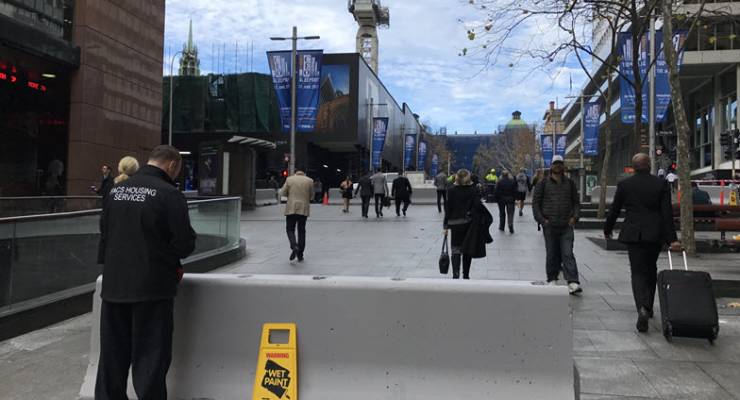
Bollards in Martin Place
There’s plenty of angst in Melbourne and Sydney over the concrete bollards installed this month in nine major public spaces, including Federation Square, Bourke Street mall, and Southern Cross Station in Melbourne and Martin Place in Sydney. The Age fed the anguish, titling its report, “What next – barbed wire?“.
While most reaction seems resigned acceptance, many think the bollards, despite the current retro-fashion of architectural brutalism, are ugly. There are also practical concerns like the impact on pedestrian movement and how to give trams and service vehicles access to some areas.
There are those who think the move overstates the risk and will increase social anxiety, and some who charge the state with using fear of terrorism to increase control over citizens. Another argument is it’s pointless because terrorists and psychos will just substitute other means of mass killing for vehicle attacks.
Some matters to consider:
- It was widely ignored, but the Victorian government emphasised the bollards installed last week are temporary and will be replaced over the next year with something more attractive; There’s plenty of scope to improve appearance and functionality: for example, bench seats, street art, planter boxes, ponds (useful for isolating tram tracks), terraced walls;
- Governments have taken this measure following vehicle attacks in Nice, London and in Melbourne’s Bourke Street mall. The risk of being a casualty of such an attack seems very low, but that’s also true of airline crashes and high-rise fires. No one really knows what the current level of risk is. We’re deeply worried about fire safety in residential towers at present, so this anxiety isn’t that surprising;
- It’s not just about terrorists using vehicles as bombs or as a means of mowing down pedestrians; there’s also a risk that drugaffected drivers might deliberately drive into crowds;
- The experience with both gun control and suicides suggests that limiting opportunities really does reduce casualties;
- The economic costs of installing bollards to protect public spaces are vastly lower than the time-consuming security procedures associated with air travel. Once they’re in place the operating costs are low;
- Some of these locations — like Federation Square — already have bollards to prevent parking, albeit daintier ones than the new behemoths;
- There’s a safety benefit in providing a barrier between moving vehicles and pedestrians. We rely heavily on parked cars to provide a buffer against unintentional crashes, but we’re also reducing the number of on-street parking spaces in the city centre (e.g. like here); and
- The “big picture” solution is to eliminate vehicles in the CBD. That’s desirable and practical for other reasons, but it would take time to implement. It would also be expensive (but not impossible) because service vehicles and public transport still require access to streets. We should nevertheless recognise the risk of vehicle attack adds to the case for removing non-essential vehicles from pedestrian-intensive locations.
In the meantime, we could choose to see this as an opportunity to do more with public spaces. Street art is the default option for improving the appearance of bollards, but there are others. For example, the bollards could be replaced with plinths carrying small statues of significant historical figures like Jesse Vasey and William Barak. They could be supported by media and they could be themed by location, e.g. those around Federation Square might tell the story of Australian art or the story of federation.
*This article was originally published at Crikey blog The Urbanist








Crikey is committed to hosting lively discussions. Help us keep the conversation useful, interesting and welcoming. We aim to publish comments quickly in the interest of promoting robust conversation, but we’re a small team and we deploy filters to protect against legal risk. Occasionally your comment may be held up while we review, but we’re working as fast as we can to keep the conversation rolling.
The Crikey comment section is members-only content. Please subscribe to leave a comment.
The Crikey comment section is members-only content. Please login to leave a comment.